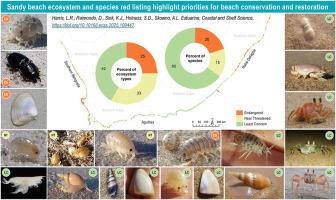Sandy beach ecosystem and species red listing highlight priorities for beach conservation and restoration
IF 2.6
3区 地球科学
Q1 MARINE & FRESHWATER BIOLOGY
引用次数: 0
Abstract
Sandy beach ecosystems and species are often referred to as ‘threatened’ or even ‘endangered’. These terms carry specific meaning in the context of IUCN Red Listing, and although the expert judgement is largely correct, rarely are there formal assessments to back up the claims that beach ecosystems and species are at risk. Our aim was to undertake the first ecosystem and species red listing for sandy beaches and their macrofauna. The IUCN Red List of Ecosystems criteria were applied to the 12 sandy beach ecosystem types in South Africa, using ecosystem maps, data on pressures to beaches, and structured expert assessment. The IUCN Red List of Species criteria were applied to 20 macrofauna species, using data from GBIF, iNaturalist, and field sampling, maps of threats to beaches, literature, and expert opinion. Three ecosystem types are Endangered, with a further four types being Near Threatened, and the remaining five being Least Concern. Of the 20 species assessed, four are Endangered (Tylos capensis, Tylos granulatus, Acanthoscelis ruficornis, Donax serra), three are Near Threatened (Africorchestia quadrispinosa, Capeorchestia capensis, Pachyphaleria capensis), and the remaining 13 are Least Concern. Notably, six of the seven threatened and Near Threatened species are supralittoral animals, and the other is harvested. We propose doing these analyses worldwide because systematic red listing can benchmark the risk of beach ecosystem and biodiversity loss, and highlight priorities for conservation and restoration, especially given the goals and targets in the Kunming-Montreal Global Biodiversity Framework.

沙滩生态系统和物种红色名录突出了海滩保育和修复的重点
沙滩生态系统和物种通常被称为“受威胁”甚至“濒危”。这些术语在世界自然保护联盟红色名录的背景下具有特定的含义,尽管专家的判断在很大程度上是正确的,但很少有正式的评估来支持海滩生态系统和物种处于危险之中的说法。我们的目标是为沙滩及其大型动物进行第一次生态系统和物种红色名录。利用生态系统地图、海滩压力数据和结构化专家评估,将世界自然保护联盟生态系统红色名录标准应用于南非的12种沙滩生态系统类型。IUCN物种红色名录标准应用于20种大型动物,使用了GBIF、iNaturalist和实地抽样的数据、海滩威胁地图、文献和专家意见。三种生态系统类型是濒危的,另外四种类型是近危的,剩下的五种是最不关注的。在被评估的20个物种中,有4个是濒临灭绝的物种,分别是黄花蓟马、黄花蓟马、沙棘棘球绦虫和黄颡鱼(Donax serra), 3个是近危物种,分别是非洲四棱绒蚧(africorestia quadrispinosa)、黄花绒蚧(Capeorchestia capensis)、黄花绒蚧(Pachyphaleria capensis),其余13个是最不受关注的物种。值得注意的是,七种濒危和近濒危物种中有六种是濒海动物,另一种是被捕捞的。我们建议在全球范围内进行这些分析,因为系统的红色名录可以衡量海滩生态系统和生物多样性丧失的风险,并突出保护和恢复的优先事项,特别是考虑到《昆明-蒙特利尔全球生物多样性框架》的目标和指标。
本文章由计算机程序翻译,如有差异,请以英文原文为准。
求助全文
约1分钟内获得全文
求助全文
来源期刊
CiteScore
5.60
自引率
7.10%
发文量
374
审稿时长
9 months
期刊介绍:
Estuarine, Coastal and Shelf Science is an international multidisciplinary journal devoted to the analysis of saline water phenomena ranging from the outer edge of the continental shelf to the upper limits of the tidal zone. The journal provides a unique forum, unifying the multidisciplinary approaches to the study of the oceanography of estuaries, coastal zones, and continental shelf seas. It features original research papers, review papers and short communications treating such disciplines as zoology, botany, geology, sedimentology, physical oceanography.

 求助内容:
求助内容: 应助结果提醒方式:
应助结果提醒方式:


